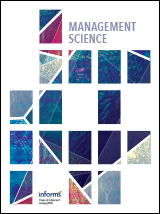Academic articles
Practitioner articles
Working papers
Books
Book chapters
Case studies
Other publications
Subject(s)
Information technology and systems; Technology, R&D management; Unspecified
Keyword(s)
a-paper, crisis, Projekt-ATHENE-SecUrban, Projekt-NEBULA, Ranking-ImpactFactor, social media, student
Volume
96
Journal Pages
103880
ISSN (Online)
2212-4209
Subject(s)
Strategy and general management; Technology, R&D management
Keyword(s)
innovation, innovation strategy, new product development, crowdsourcing, customer engagement, innovation contests
Volume
65
Subject(s)
Human resources management/organizational behavior
Keyword(s)
error management, psychological safety, automation
Volume
2023
Journal Pages
22–25
Subject(s)
Information technology and systems; Technology, R&D management; Unspecified
Keyword(s)
cyberspace, cyberwar, arms control
Volume
16
Journal Pages
289–310
ISSN (Online)
1866-2196
ISSN (Print)
1866-2188
Subject(s)
Health and environment; Management sciences, decision sciences and quantitative methods; Product and operations management
Keyword(s)
reusability, reuse, innovation, markov decision process
Volume
3
Journal Pages
100021
ISSN (Online)
2667-2596
Subject(s)
Human resources management/organizational behavior
Keyword(s)
validity, reproducibility, open science, transparency, research process
Volume
18
Journal Pages
1230–1243
Subject(s)
Diversity and inclusion; Management sciences, decision sciences and quantitative methods; Strategy and general management
Keyword(s)
Matthew effect, performance evaluation, luck, organizational learning
Success tends to increase and failure tends to decrease the chances of future success. We show that this impact of past outcomes can change how diagnostic success or failure are regarding the competence of an individual or a firm. Succeeding under adverse circumstances is especially impressive when initial failure reduces the chances of success more for low-quality agents than for high-quality agents. Succeeding after initial failure (being a ”successful underdog”) can also indicate higher expected quality than succeeding twice if initial success increases the chances of success of all agents to a high level. In different circumstances, the outcome after success can be especially informative about quality, implying that failing after an initial success (a ”one-hit wonder”) indicates lower quality than failing twice does. We find effects consistent with our model in data on Canadian professional hockey players and on data from the Music Lab experiment: initial failure combined with eventual success is associated with high quality. The results help to clarify when failure should be attributed to the person in charge or to the situation, when underdogs and individuals who overcome adversity are especially impressive, and when a na¨ıve ”more is better” heuristic for evaluating performance can be misleading.
© 2022, INFORMS
Volume
69
Journal Pages
5461–5481
ISSN (Online)
1526-5501
ISSN (Print)
0025–1909
Subject(s)
Human resources management/organizational behavior
Keyword(s)
lifelong learning, professional development, executive education, micro-learning, time management, collaborative learning, AI in education, digital tools, motivation
JEL Code(s)
D38
ISSN (Print)
0015-6914
Subject(s)
Strategy and general management
Keyword(s)
agility, organizational change, strategic alignment, incremental innovation, strategy
Volume
65
Journal Pages
63–92
Subject(s)
Human resources management/organizational behavior
Keyword(s)
leadership, management communication, managerial behavior, managing employees, meeting management, presentation skills, emotional intelligence, listening skills, public speaking
Online meetings are now part of our normal daily routines. They are easy to set up, we have hardware to make them happen, multiple software solutions and high-speed internet enable the connection. But are we really good at communicating virtually? Did we really unmute?
This multimedia case builds on a recording of a not-so successful meeting (we will refer to this video as “The Meeting”) of a distributed team. The recording is not from a real-life business meeting but a plot scripted by the authors to point out learning content and enacted by professional actors. The 5.5 minutes meeting clip activates a set of challenges that we face in online meetings:
– Unclear communication;
– Missing connection between the members;
– Lack of engagement;
– Issues with the technology.
During the case discussion students learn how they can master interactions online, create better connections with other meeting participants, and how they can maximize their online presence.
This multimedia case builds on a recording of a not-so successful meeting (we will refer to this video as “The Meeting”) of a distributed team. The recording is not from a real-life business meeting but a plot scripted by the authors to point out learning content and enacted by professional actors. The 5.5 minutes meeting clip activates a set of challenges that we face in online meetings:
– Unclear communication;
– Missing connection between the members;
– Lack of engagement;
– Issues with the technology.
During the case discussion students learn how they can master interactions online, create better connections with other meeting participants, and how they can maximize their online presence.
| buy now | buy now | buy now |

